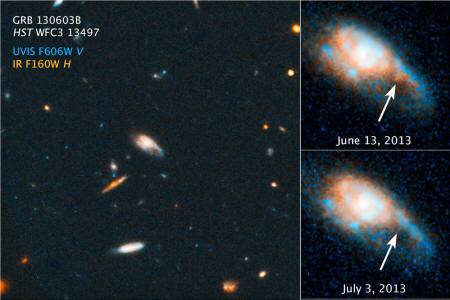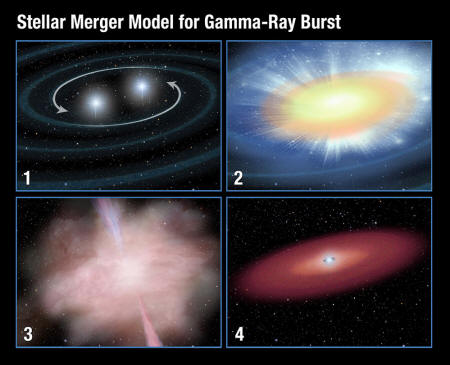|

by Charles Q. Choi
Contributor
August 03, 2013
from
Space Website

These images taken by NASA’s Hubble Space
Telescope reveal a new type of stellar explosion
produced by the merger of two compact objects:
either two neutron stars or a neutron star and a
black hole. The galaxy in the center of the left
image produced the gamma-ray burst, whose
lingering effects were visible on June 13 but
had faded by July 3.
Credit: NASA, ESA, N. Tanvir (University of
Leicester), and A. Fruchter, Z. Levay (Space
Telescope Science Institute), A. Levan
(University of Warwick)
Cataclysmic crashes involving
black holes and ultradense neutron
stars may explain the briefest of the most powerful explosions in
the universe, scientists say.
NASA scientists are calling the new type of short, but intense,
cosmic collision and conflagration a "kilonova," an explosion so
powerful it is 1,000 times stronger than a typical star explosion,
called
a nova. Such events have long been predicted by astronomers,
but never seen until now, researchers said.
The discovery could shed light on the
origin of heavy elements such as
gold and platinum, they added.
Gamma-ray bursts are the most intense outbursts ever detected,
giving off as much energy in an instant as our sun will beam out
during its entire 10-billion-year lifetime. A nearby burst directed
at Earth could easily cause a
mass extinction, researchers say.
There are two kinds of gamma-ray bursts - ones that are
longer-lived, lasting more than two seconds, and less common
short-lived ones, lasting about two seconds or less.
Scientists have suggested these brief gamma-ray bursts might be
caused by cataclysmic mergers of incredibly dense cosmic bodies -
either two
neutron stars (the tiny remnants of
exploded stars) or a neutron star and a black hole.
However, they
lacked evidence until now.
Astronomer Nial Tanvir at the University of Leicester in
England and his colleagues analyzed the short gamma-ray burst
GRB
130603B, which exploded about 4 billion light-years away on June 3.
NASA's
Swift satellite measured it as
0.18 seconds long, while NASA's Wind spacecraft determined that it
lasted only 0.09 seconds.
The mergers of dense cosmic bodies that are thought to cause short
gamma-ray bursts can also blast out neutron-rich gas that rapidly
generates heavy elements such as gold and platinum, scientists say.
These "r-process" elements can undergo radioactive decay and release
an enormous amount of energy - 1,000 times or so that given off by
stellar explosions such as novas.
These powerful events are thus known as
"kilonovas" ("kilo" means "thousand" in Greek).

This
sequence illustrates a model for the formation of a
short-duration gamma-ray burst to become a powerful kilonova
explosion. Here, two neutron stars circle one another and
ultimately collide to kick out highly radioactive material. This
material heats up and expands, emitting a burst of light called
a kilonova. An accompanying gamma-ray burst lasts just one-tenth
of a second, but is 100 billion times brighter than the kilonova
flash. Image released Aug. 3, 2013.
Credit: NASA, ESA, and A. Field (STScI)
NASA's Hubble Space Telescope revealed
that the near-infrared afterglow that accompanied GRB 130603B was
the kind one would expect from a kilonova.
This is smoking-gun evidence that an
explosive merger caused the gamma-ray burst, Tanvir told SPACE.com.
"This is just the first example, and
we will have to search for and study others to be completely
sure, but it certainly looks right," Tanvir said.
It remains uncertain what kind of merger
caused this kilonova and gamma-ray burst.
The theoretical predictions for these
mergers and the behavior of kilonovas,
"still have many uncertainties, so
it is too early to try to distinguish these possibilities,"
Tanvir said.
In the future, the researchers aim to
find other examples of kilonovas accompanying short gamma-ray
bursts.
Tanvir added that future research into
kilonovas could shed light on the origin of r-process elements.
"The r-process elements are heavy
elements whose origin we have long been uncertain about," Tanvir
said.
"They are not produced in normal
stars, and astronomers have generally assumed they must be
created in supernovae. However, the calculations suggest
supernovae may not be good at creating those elements, so it is
possible that kilonovae from merging compact objects may be the
primary route in the universe to producing these elements."
The scientists detailed their findings
online Aug. 3 in the journal Nature.
|


